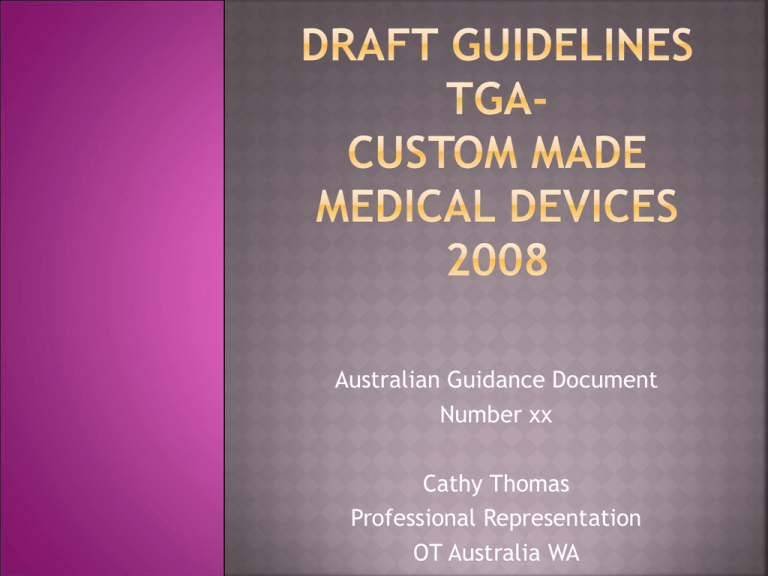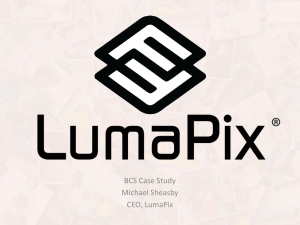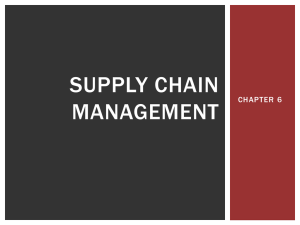Custom Made Medical Devices
advertisement

Australian Guidance Document Number xx Cathy Thomas Professional Representation OT Australia WA Therapeutic Goods Administration web site http://www.tga.gov.au/devices/drcustom.pdf Disclaimer- “This document is provided for guidance only” Australian regulatory guidelines for medical devices (Jun 2010)- Custom made medical devices section is “yet to be drafted” Purpose: The regulatory framework for medical devices contains provisions for regulation of custom made medical devices and the components of customised medical devices, relating to Demonstrating compliance -essential safety and performance Documentation of manufacturing process Labelling of finished devices Record keeping Post market reporting Notification manufacturing activities to TGA Regulation of medical devices is intended to ensure that all devices have been shown by the manufacturer to comply with the Essential Principles of Safety and Performance Devices that are assembled, adapted, processed or used in accordance with the manufacturer’s intentions will comply with the Essential Principles A person who customises a device from components supplied by others IS NOT REQUIRED to perform the relevant investigations to determine if the finished product complies with the Essential Principles A Manufacturer is the person who is responsible for the design, production, packaging and labelling of a device before it is supplied A person is NOT the Manufacturer if the person assembles or adapts the device for an individual patient And, the device has already been supplied, And, the assembly or adaption of the device DOES NOT CHANGE THE PURPOSE INTENDED FOR THAT DEVICE CUSTOMISED MEDICAL DEVICES VS CUSTOM MADE MEDICAL DEVICES CUSTOMISED MEDICAL DEVICES A CUSTOMISED MEDICAL DEVICE is a medical device that is prepared/assembled by a person who is not the manufacturer of the device, but The person assembles or adapts the device for an individual patient The device has already been supplied The assembly of the device does not change the purpose intended for the use of the device (by means of information supplied, labelling, instructions for use, advertising material) CUSTOMISED MEDICAL DEVICES are considered to be: Assembled from components which are mass produced, with the intent these components be assembled into a finished medical device for an individual patient The device should perform as intended if assembled in accordance with manufacturer’s instructions Should comply with the Essential Principles Examples of Customised Medical devices are: Plaster or fibreglass splint used to support a fracture using materials specifically intended for this purpose Purchased cushioning pre-shaped to accommodate user specific seating and positioning requirements, may be fixed or in a wheelchair Artificial limbs constructed of component parts CUSTOM MADE MEDICAL DEVICES CUSTOM MADE MEDICAL DEVICES are considered to be: Constructed from materials, components or elements where there was no specific intention by the manufacturer that the materials be used in the manufacture of a medical device May include metals, adhesives, plastics, fibreglass, glass etc from commercial sources “Healthcare practitioners who create and provide custom made medical devices to their patients are therefore considered MANUFACTURERS of custom made medical devices” Examples of Custom Made medical devices are: Plaster cast using commercially available plaster of Paris and gauze bandage material A complete wheelchair or seating specifically constructed to accommodate seating and positioning of the user A dynamic splint where components using welding rod, paper clips and fishing line have been added The custom fitted socket for an artificial limb (so even only part of a customized device may be custom made) The Manufacturer (the OT) of Custom Made medical devices (or part thereof) must be able to demonstrate that as far as possible the finished device will be in accordance/compliance of the Essential Principles of safety and performance for medical devices and must establish and maintain a process for identifying potential hazards associated with their custom made device, associated risks, controlling risks and monitoring effectiveness of control methods Information to be provided with the device The manufacturer’s name, or trading name, and address The intended purpose of the device, the intended user of the device, and the kind of patient on whom the device is intended to be used (if this information is not obvious) Sufficient information to enable a user to identify the device, or if relevant, the contents of packaging Any particular handling or storage requirements applying to the device Any warnings, restrictions, or precautions that should be taken, in relation to use of the device Any special operating instructions for the use of the device If applicable, an indication that the device is intended for a single use only An indication that the device has been custom-made for a particular individual and is intended for use only by that individual If applicable, an indication that the device is intended to be used only for clinical or performance investigations before being supplied For a sterile device, the word ‘STERILE’ and information about the method that was used to sterilise the device The batch code, lot number or serial number of the device If applicable, a statement of the date (expressed in a way that clearly identifies the month and year) up to when the device can be safely used If the information provided with the device does not include the information mentioned in item 12 — a statement of the date of manufacture of the device (this may be included in the batch code, lot number or serial number of the device, provided the date is clearly identifiable) Some suggestions for what we can start to do to comply: Have procedures and protocol files up-todate and patterns drawn up so your regular items are reproducible by any therapist Document any safety considerations incl precautions, do’s and don’ts Have patient handouts providing instruction on care, safety, use, when to return to therapist, intention of use, date of manufacture, batch no, contact details Record batch numbers, exact type of product manufactured, supplier details (if relevant) against patient’s name Provide suppliers with patient details when ordering specific or specialised products in case of need for recall







![Spec Section 066000 Rev1[2]](http://s3.studylib.net/store/data/007183801_1-bbe4ba56f9f6f9f9b2209fb086ce54ad-300x300.png)